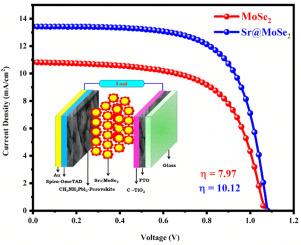Strontium encapsulated molybdenum diselenide as an enhanced electron transport layer for high efficiency perovskite solar cells
引用次数: 0
Abstract
Perovskite solar cells (PSCs) have emerged as a transformative technology in photovoltaics due to their high absorption coefficient and potential for low-cost, high-efficiency solar energy conversion. Optimizing the electron transport layer (ETL) remains a critical challenge, as it significantly influences charge carrier dynamics and overall device performance. This study explores strontium (Sr) doped hydrothermally synthesized molybdenum diselenide (MoSe2) as ETL to enhance the power conversation efficiency (PCE) of the PSCs. The encapsulation of Sr within MoSe2 (Sr@MoSe2) demonstrates a notable enhancement in photovoltaic parameters, achieving a short-circuit current density (Jsc) of 13.73 mA/cm², an open-circuit voltage (Voc) of 1.04 V, a fill factor (FF) of 82%, and a power conversion efficiency (PCE) of 10.12%, compared to pristine MoSe2 (Jsc = 11.05 mA/cm², Voc = 1.03 V, FF = 70%, PCE = 7.97%). Transient photovoltage and impedance spectroscopy analysis confirm that Sr modification facilitates improved charge extraction and reduces recombination losses at the ETL perovskite interface. These results underscore the effectiveness of Sr incorporation in enhancing both the efficiency and operational stability of perovskite solar cells. This work not only provides a promising strategy for ETL optimization but also opens avenues for future research into tailored material engineering for next-generation photovoltaic devices.

锶包封二硒化钼作为高效钙钛矿太阳能电池的增强电子传输层
钙钛矿太阳能电池(PSCs)由于其高吸收系数和低成本、高效率的太阳能转换潜力而成为光伏发电领域的一项革命性技术。优化电子传输层(ETL)仍然是一个关键的挑战,因为它显着影响载流子动力学和整体器件性能。本研究探讨了锶(Sr)掺杂水热合成二硒化钼(MoSe2)作为ETL,以提高psc的功率转换效率(PCE)。与原始MoSe2 (Jsc = 11.05 mA/cm²,Voc = 1.03 V, FF = 70%, PCE = 7.97%)相比,Sr封装在MoSe2 (Sr@MoSe2)中,光伏参数得到了显著提高,短路电流密度(Jsc)为13.73 mA/cm²,开路电压(Voc)为1.04 V,填充系数(FF)为82%,功率转换效率(PCE)为10.12%。瞬态光电压和阻抗谱分析证实,Sr改性有助于改善电荷提取,并减少ETL钙钛矿界面的复合损失。这些结果强调了锶掺入在提高钙钛矿太阳能电池的效率和运行稳定性方面的有效性。这项工作不仅为ETL优化提供了一个有前途的策略,而且为下一代光伏器件定制材料工程的未来研究开辟了道路。
本文章由计算机程序翻译,如有差异,请以英文原文为准。
求助全文
约1分钟内获得全文
求助全文

 求助内容:
求助内容: 应助结果提醒方式:
应助结果提醒方式:


